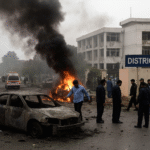On May 7, 2025, the Indian Air Force (IAF) launched a high-stakes retaliatory operation targeting suspected militant bases inside Pakistan. Flying deep-strike missions under Operation Sindoor, Rafale jets India’s pride in modern air combat took off expecting a clean sweep. But within hours, that confidence dissolved into one of the most stunning air combat upsets in regional history.
Intercepted and outmaneuvered by Pakistan Air Force (PAF) J-10C fighters equipped with long-range PL-15E missiles, at least one Rafale was confirmed lost marking the first-ever downing of the French-built jet in active combat. The incident exposed a combination of tactical missteps, intelligence blind spots, and outdated engagement doctrines.
Pakistan’s Ambush: A Modern-Day Masterclass
The operation carried out by the PAF showcased a new era of air warfare where data networks matter more than airframes.
🧠 How the Ambush Played Out
-
Surveillance Support: Pakistan deployed a mix of Saab 2000 Erieye and Chinese ZDK-03 airborne early warning systems (AEW&C), feeding real-time target data to J-10C squadrons.
-
Stealth Approach: Flying at low altitudes and in complete radio silence, the J-10Cs remained below IAF radar detection thresholds.
-
The Kill Shot: At a distance of roughly 180–200 km, the PL-15E missiles were launched. With mid-course updates from AEW&C aircraft and terminal radar seekers, these missiles struck before Indian pilots could respond.
The entire encounter occurred without Pakistani fighters ever entering Indian airspace.
The Intelligence Failure: A Dangerous Miscalculation
One of the biggest surprises was India’s underestimation of Pakistan’s missile capability specifically the real operational range of the PL-15E.
Indian assessments reportedly capped the missile’s effective range at 150 km. In reality, it exceeded 200 km when assisted by offboard sensors. The IAF also failed to anticipate Pakistan’s seamless integration of Chinese and Western surveillance systems.
This oversight left India’s pilots flying blind in a zone they falsely believed was safe.
The Rafales Were Ill-Equipped for the Fight
While the Rafale is a world-class multirole fighter, its mission loadout on that day was tailored for deep-strike—not air superiority.
💣 Loadout Breakdown:
-
MICA IR Missiles: Infrared-guided, short-range (~60 km) weapons—ineffective against long-range threats.
-
No MICA EM: The extended-range radar-guided variant (80+ km) was reportedly not equipped.
-
No Meteor Missiles: India’s prized long-range BVR missile wasn’t carried on this sortie.
In simple terms, India’s best jets were flying without the right tools for the threat they faced.
Strategic Fallout: Military and Diplomatic Shockwaves
The ambush had immediate ripple effects across military and defense industries:
-
India: Tactical reviews were swiftly ordered. Future missions saw heavy use of standoff weapons like BrahMos and SCALP missiles to avoid direct dogfights.
-
France: Dassault Aviation, maker of the Rafale, faced investor anxiety amid rising doubts about its jet’s survivability.
-
China: The Chengdu J-10C platform saw renewed interest internationally, including from potential buyers in the Middle East and Southeast Asia.
-
Pakistan: Gained regional prestige for showcasing effective use of network-centric and long-range engagement doctrines.
Five Lessons That Will Redefine Regional Air Warfare
1. Sensor Dominance > Platform Specs
Data-sharing between aircraft, AWACS, and ground control now trumps raw aircraft performance.
2. Missile Range Is Everything
Without weapons like the Meteor or PL-15E, even elite jets are vulnerable from afar.
3. Electromagnetic Silence Works
Avoiding radar emissions and radio chatter kept Pakistani jets invisible until it was too late.
4. Accurate Threat Intel Saves Lives
Failure to understand an adversary’s capabilities leads to strategic blind spots.
5. Right Loadout for the Right Mission
Modern air battles can be won—or lost—based on missile selection and aircraft readiness.
FAQs
Was this the first Rafale jet ever shot down in combat?
Yes, the May 7 incident marks the first confirmed combat loss of a Rafale fighter.
What is the PL-15E missile, and why is it significant?
The PL-15E is a long-range air-to-air missile used by the PAF J-10C. With an estimated range of 200 km and advanced guidance, it allows “first-look, first-shot” capability.
Did Pakistan violate Indian airspace during the attack?
No. The Pakistani jets stayed within their own airspace, using long-range missiles to neutralize targets across the border.
Why didn’t the Indian Rafales detect or respond?
They were likely loaded for ground attack and lacked long-range defensive missiles like the Meteor or MICA EM. Radar silence from J-10Cs further reduced detection chances.
Conclusion
The Rafale ambush wasn’t just a singular military episode; it marked a transition in South Asia’s aerial warfare paradigm. The incident demonstrated that superior jets alone cannot win wars without accurate intelligence, robust surveillance networks, and appropriate mission configurations.
For India, it’s a lesson in the importance of doctrinal agility. For Pakistan, it was a vindication of long-term investments in integrated warfare systems and smart procurement.
As the skies over South Asia grow increasingly contested, this event will be studied for years as a turning point—where technology, timing, and tactics collided in a deadly equation.









